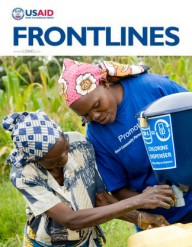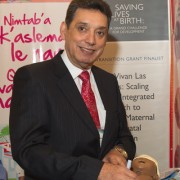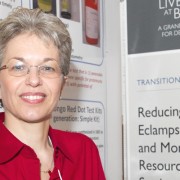“We started hearing stories about two years ago from South Sudan, remarkable stories about women’s lives being saved,” said Dr. Thomas F. Burke, chief of the Division of Global Health and Human Rights at Massachusetts General Hospital and a faculty member at Harvard Medical School.
What was happening on the ground was the result of a project Burke was leading to address post-partum bleeding in women in countries too poor to afford the kinds of devices and procedures that are commonly used in the United States and other developed countries to address the medical emergency.
“It began about four or five years ago when we were asked to come up with a way to address maternal child and newborn emergencies at the community level in South Sudan,” Burke explained.
Postpartum hemorrhaging is relatively common—with about 11 percent of all pregnancies resulting in excessive bleeding after birth—and the medical community has several sound methods to treat it, ranging from uterine massage to drugs to surgery.
The larger issue, says Burke, is addressing the problem in the developing world where equipment and expertise is often lacking. As many as 130,000 women die every year from postpartum hemorrhage and another 2.6 million women survive but are injured or disabled due to complications. Most of them live in countries without comprehensive health-care services.
“We had to ask ourselves: ‘How could we possibly, honestly address maternal hemorrhage?” Burke said. The answer: “In the developed world, there is a uterine balloon. They are single-use only, and they are very expensive. We essentially designed our own.”
Although far more sophisticated, the product uses a concept from basic first aid—apply constant pressure to an area that is bleeding to stop the flow.
Burke’s device deploys a low-cost catheter that can be sterilized in boiling water and reused; a condom, which is easy to procure in most developing countries; and water. Attach the condom to the catheter, insert the device into the uterus and introduce water through the catheter tubing to slowly inflate the condom. The condom balloons to the shape of the uterus and presses against the bleeding uterine wall. If the pressurized condom works, after about five minutes, excessive bleeding stops.
Though this isn’t the first homemade uterine balloon, Burke’s invention is part of a package that includes the device components as well as a pictorial checklist so that unskilled or illiterate health workers can successfully use it. The project also includes intensive training for those health workers, whose midwifery skills, says Burke, mostly have been handed down person to person over thousands of years.
Already, the stories coming out of South Sudan and Kenya are giving Burke and his team reason to celebrate. The South Sudan word-of-mouth successes involved just a handful of women where the device worked in all but one case. So Burke set out to replicate it in Kenya where collecting data would be easier. In a limited trial, Burke helped train midwives at 12 low-volume facilities in urban and rural Kenya. In all, there were 18 cases of postpartum hemorrhage. All 18 women survived.
“We were able to save their lives,” said Burke, who said the number has increased to 26 lives saved since the study ended.
Impressed, Kenya’s health officials have said they will place the uterine balloon in all 6,500 of the country’s health facilities. The money from Saving Lives will allow that scale-up to grow beyond Kenya and South Sudan. “The door has been opened,” says Burke, who ticks off Nepal, Senegal and Indonesia among the countries whose health ministries he has had contact with.
“This is incredibly exciting. I’ve been lucky enough to do so many interesting things in my life. This is probably the most important thing I’ve have the good fortune to do,” he said. “I’ve already been lying awake at night wondering how version 2.0 will look. There’s no shortage of follow-on about this.”
Related Links












Comment
Make a general inquiry or suggest an improvement.